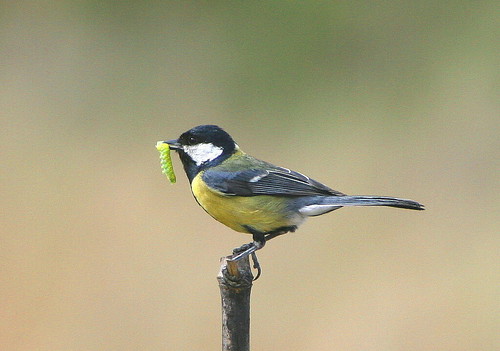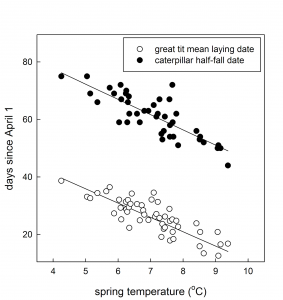
Background:
Timing is everything for bringing new life into the natural world. Every year, species such as the great tit (Parus major), one of the many song birds found on the British Isles, rely on abundant food to be able to provide enough nutrients for their growing young. The presence of this food is the result of a large cascade–like a line of dominos–that begin with the smallest of microorganisms responding to environmental factors such as temperature and salt concentration. If the timing of one of these falling dominoes is slightly off, many organisms further down the line suffer and may be unable to find food at the most critical times of early offspring growth. Two particular organisms that share the same line of dominoes as the great tit are the pendunculate oak (Quercus robur) and the various caterpillars which feed on the oak’s leaves. [3]
Climate change impacts this delicate cascade by altering the environmental factors at the origin of the domino line. Current models of predicting the impact of climate change on various species’ ability for long-term survival often neglect to include the important aspects of adaptive evolution and phenotypic plasticity. Adaptive evolution is the adjustment of a species to its surrounding environment through time and phenotypic plasticity is defined eloquently by Vedder et. al as a species’ “evolved ability to adjust their behavior depending on the environment they experience’. [3]
Another aspect influencing how well a species will survive environmental change its life history: how quickly that species produces each successive generation. Species with shorter life histories produce young faster while species with a longer life history produce fewer young, and over a longer period of time. All of these various factors interact to enable a species such as the great tit to potentially survive changes in climate during the years to come.
Primary Question:
In their experiment, Vedder et. al sought to determine the impact of phenotypic plasticity and adaptive evolution on the likelihood of a species’ continued survival in the wake of a changing climate. Using data from their 51- year study and a model crafted by Chevin et. al, [2] this research group sought to add these more inclusive parameters to standing climate change prediction models. Additionally, Vedder et. al attempted to apply their findings broadly and determine the impact of additional factors, such as reproductive rate, on climate change survivability.
Evidence:
Vedder et. all examined several different factors affecting great tit’s survival. These include average yearly spring temperature (the great tit’s breeding season); average date of egg laying; caterpillar height of abundance date; and the number of days since April 1st that the laying an abundance occurred during the 51-year study. The researchers then compared the date of egg laying to spring temperature, abundance timing to spring temperature, and then all factors simultaneously. First, they found that increases in average temperature resulted in female tits laying their eggs an average of 4.98 (0.49 standard error) days earlier than usual per degree Centigrade. [3] Also, the peak date of caterpillar abundance was similarly influenced, as caterpillars were most present an additional 5.30 (0.56 standard error) days earlier per degree Centigrade. When all the factors were compared together, Vedder et. all found strong relationships that supported each of these individual comparisons.

These values were incorporated into the Chevin et. all equation [2] to account for varying levels of phenotypic plasticity and life history length:
Vedder and associated crew found that phenotypic plasticity is highly responsible for the great tit’s ability to adequately adapt and survive continued changes in climate. But, without the aid of phenotypic plasticity, the risk of extinction for the tit rises to a 60% probability. [3] Additionally, organisms with shorter life histories were noted to have a better chance of avoiding extinction. This is because greater offspring production creates more chances microevolutionary forces, such as adaptation, to act upon the population, which can result in higher potential phenotypic plasticity over the long term. In conclusion, phenotypic plasticity and adaptive evolution are extremely important factors for climate change models to include and to exclude them would generate less accurate predictions. This is especially important in a time when the general public and certain branches of the American government already have a difficult time accepting the existence of climate change, and the use of poor models may shake the public’s confidence in climate scientists’ social recommendations.
Future Research Project Directions:
One option for a future study on this topic is to incorporate different species’ strengths of response to changing temperatures. Species A may have a slight response (a change in egg lay date by a day or two), while another in the same environment may have a more drastic response (a change of more than a week for the same temperature difference, or another response entirely such as average number of eggs per clutch). Other studies could examine adaptability of species to different kinds of environmental stresses brought by climate change. Shifting wind patterns and differences in silt concentration from glacially-fed rivers are two are two factors that could be important for air-faring species or fisheries system stability. The uncertainty of each species’ response to climate change exposes the necessity of research in years to come.
Additional Links:
Want to check out the environmental change equation at its source? You can find the original Chevin et. al paper here:
Interested in further reading? The following is a paper also on the topic of phenotypic plasticity and its relation to climate change in plant species:
Citations:
- “Carbonero Con Oruga. Great Tit with Caterpillar.” Flickr. Yahoo!, 3 Aug. 2009. Web. 8 Apr. 2015. <https://www.flickr.com/photos/kateimi/3562016437/>.
- Chevin, Luis-Miguel, Russell Lande, and Georgina M. Mace. “Adaptation, plasticity, and extinction in a changing environment: towards a predictive theory.”PLoS biology 4 (2010): e1000357.
- Vedder, Oscar, Sandra Bouwhuis, and Ben C. Sheldon. “Quantitative assessment of the importance of phenotypic plasticity in adaptation to climate change in wild bird populations.”PLoS biology 7 (2013): e1001605.
